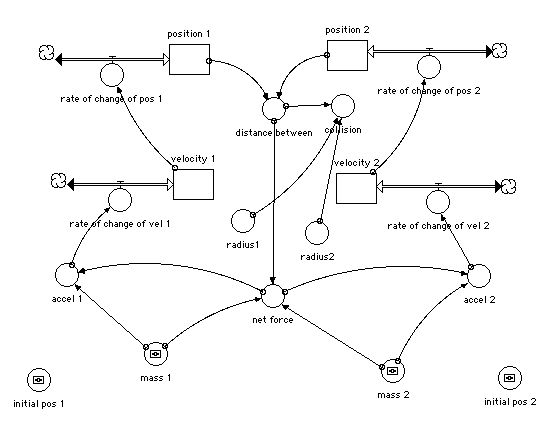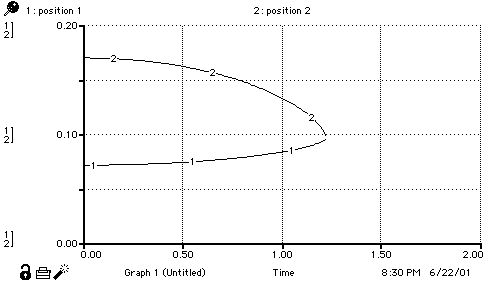
|
Universal Gravitation Activity |
| This model shows the effect of gravitational attraction between two objects, demonstrating that gravitational forces are directly proportional to mass of each body, but inversely proportional to the square of the distance between the bodies. The model may be easily modified to demonstrate Coulomb's Law. |
|
TEACHER RESOURCES
Teacher Materials Student Activity Student Assessment Learning Goals/Standards |
COMPUTER MODEL STELLA Version
|
COMPUTER MODEL Vensim Version
|
 |
|
position_1(t) = position_1(t - dt) + (rate_of_change_of_pos_1) * dt INIT position_1 = initial_pos_1 rate_of_change_of_pos_1 = velocity_1 position_2(t) = position_2(t - dt) + (rate_of_change_of_pos_2) * dt INIT position_2 = initial_pos_2 rate_of_change_of_pos_2 = velocity_2 velocity_1(t) = velocity_1(t - dt) + (rate_of_change_of_vel_1) * dt INIT velocity_1 = 0 rate_of_change_of_vel_1 = accel_1 velocity_2(t) = velocity_2(t - dt) + (rate_of_change_of_vel_2) * dt INIT velocity_2 = 0 rate_of_change_of_vel_2 = accel_2 accel_1 = net_force/mass_1 accel_2 = -net_force/mass_2 collision = if (distance_between<(radius1+radius2+ .005)) then pause else 0 distance_between = ABS(position_2-position_1) initial_pos_1 = 0 initial_pos_2 = .2 mass_1 = 6E6 mass_2 = 6E6 net_force = 6.67E-11*(mass_1*mass_2)/(distance_between^2) radius1 = .001 radius2 = .001 |
 |
|
|